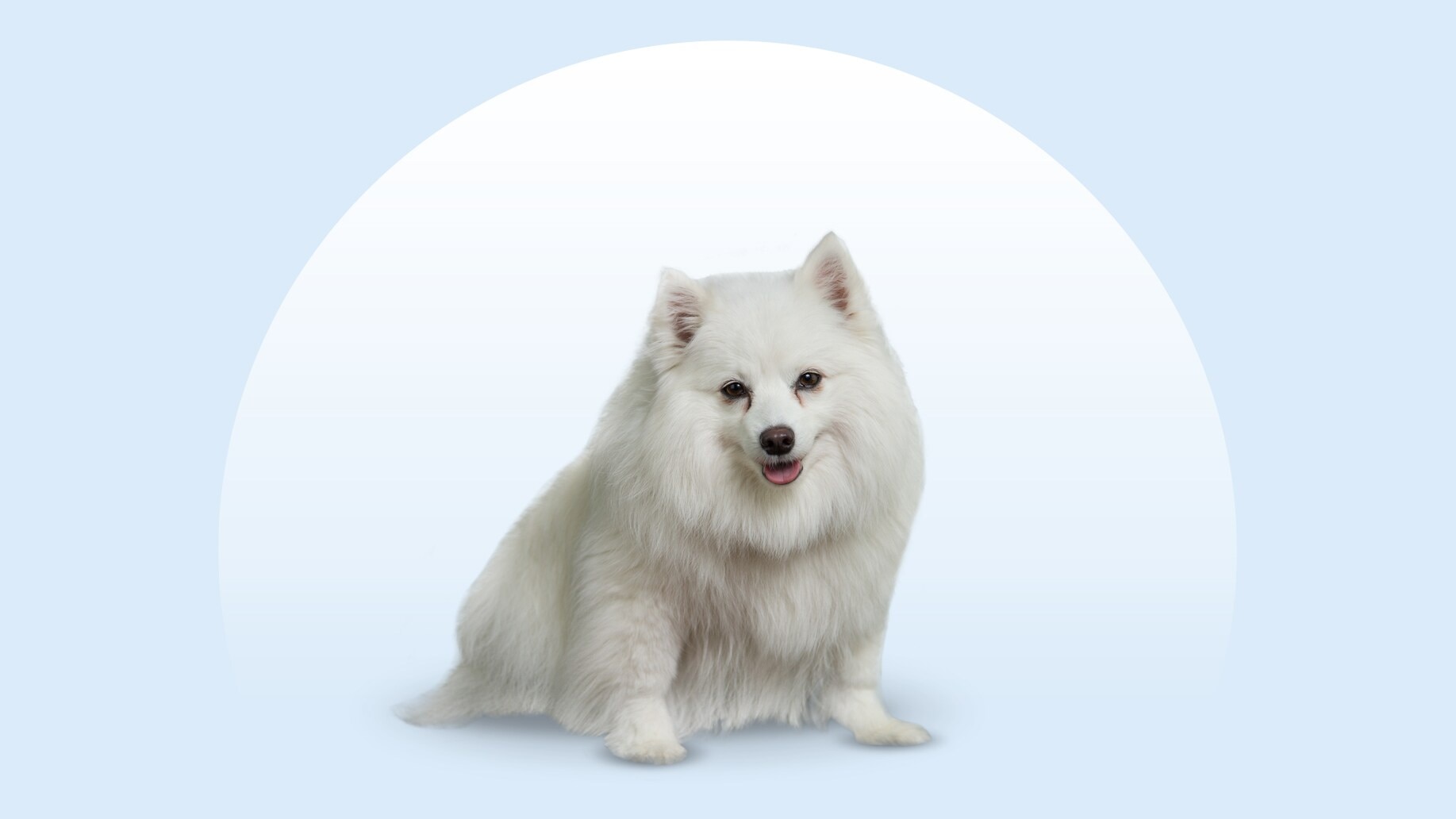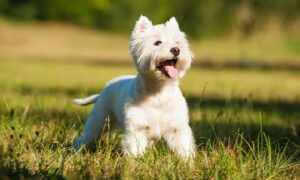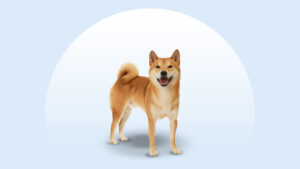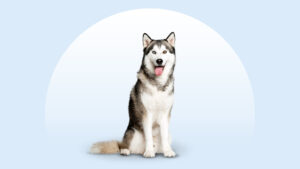American Eskimo Dog
Updated January 7, 2025
American Eskimo Dog
Updated January 7, 2025
Social Butterfly, Energetic, Super Smart
Toy: 6-10 pounds
Miniature: 10-20 pounds
Standard: 25-35 pounds
Toy: 9-12 inches
Miniature: 12-15 inches
Standard: 15-19 inches
13 to 15 years
White, White And Biscuit
Ready to be entertained? The American Eskimo Dog has all the makings of a star performer: Their polar-white fur is eye-catching, their agility is worthy of the center ring and they’ll literally jump through hoops to get your attention. A rare breed with head-turning looks and a bubbly, highly extroverted personality, you’ll often find the Eskie grandstanding for affection. They may steal the show in public, but it’s really you they want to please. This little dog will turn up the volume on your life’s activities with dazzle and panache. Your favorite pop star will never measure up.
American Eskimo Dog Characteristics
American Eskimo Dog Appearance
The American Eskimo Dog features an eye-catching double coat and a plumed tail. These small pups come in three sizes: standard (often confused for small Samoyeds), miniature and toy (often mistaken for white Pomeranians). They are white and have a distinctive Nordic-type face accented with a black button nose. The longer hair around their necks and chests creates a ruff—ready to waltz into Queen Victoria’s royal court!
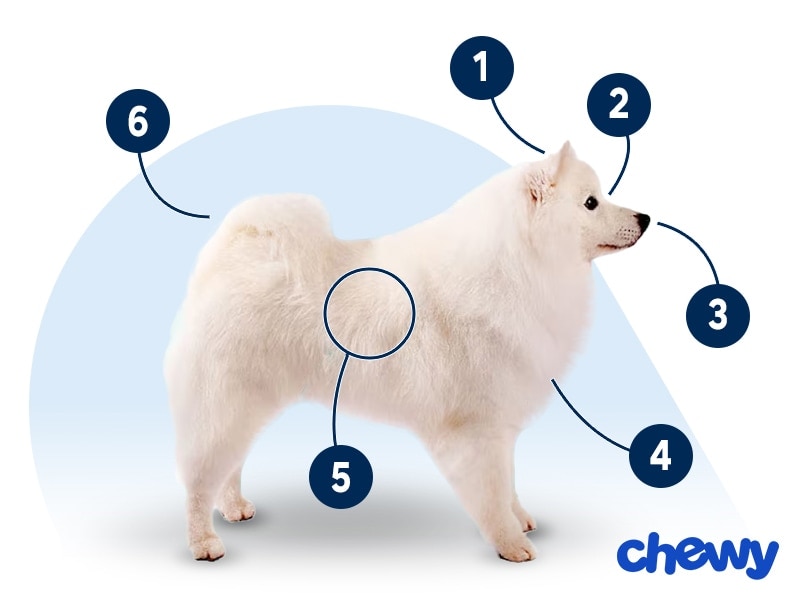
- Ears
American Eskimo ears are small, upright and triangular with slightly blunted tips.
- Eyes
Their eyes have a slight oval shape, are medium-sized and dark brown. Their eye rims are also dark brown or black, but their eyelashes are snow-white!
- Nose
They have broad muzzle and a nose that is either dark brown or black.
- Coat Length
American Eskimo Dogs have a fluffy double coat. (A dog with a double coat has two layers of coats: The undercoat is typically dense and more "wooly" and regulates body temperature. The top coat is typically longer and repels dirt and water.) Their hair is long, particularly around the neck and chest where it forms a lion-like ruff.
- Coat Color
The American Eskimo Dog has a beautiful white coat. Some dogs also have shades of biscuit cream colors (a slightly "toasted coconut" color).
- Tail
The American Eskimo Dog has a high-set tail that is long and fluffy.
American Eskimo Dog Temperament
The American Eskimo Dog (aka the American Spitz) has an outgoing, intelligent and friendly temperament, which means this breed is very trainable and makes a fabulous best friend. These extroverted pups form strong attachments to their people and want to spend every moment with their loved ones.
Eskies are known to be friendly and social, but that doesn’t mean you shouldn’t socialize your pup! Early socialization helps your dog make new friends (either two- or four-legged) throughout their life. If they’ve had plenty of socialization as puppies, they can live well with cats, other dogs and kids. Because they’re on the small side, small kids and babies may accidentally hurt your pup, so be sure to supervise all pupper/kiddo playtime. The Eskie’s personality is full of charm, and they live to be the center of attention.
How to Care for a American Eskimo Dog
With a dog this gorgeous, maintenance is required. American Eskimos shed, and that coat needs a lot of care to keep it fluffy and fabulous. Eskies are also high-energy pups, which means you’ll spend a lot of time exercising and training them. But hey—that just means you have more time to bond with and love on this wonderful pup.
Grooming
Training
Diet
Exercise
Environment
American Eskimo Dog Health
American Eskimos have a life expectancy of 13-15 years, and they don’t have a lot of health issues. Many of these issues are hereditary, so only purchase your puppy from a reputable breeder who screens their pups. If you’re adopting an Eskie, be sure to get a copy of the vet wellness exam to see if the dog already suffers from one of these health problems.
- Hip Dysplasia: Hip dysplasia is a condition where the hip joint isn’t formed properly. Dogs with this condition can experience difficulty walking, and the condition can get worse over time. In some cases, hip dysplasia is hereditary. Although the severity can vary, treatments like pain medication, joint supplement, physical therapy or surgery are often recommended
- Patellar Luxation: Genetics play a significant part in an American Eskimo potentially developing patellar luxation. This is a common condition where the kneecap can shift sideways (called luxating). In severe cases, surgery may be recommended, but mild cases may be treated with joint supplements or medications.
- Progressive Retinal Atrophy: American Eskimos can inherit progressive retinal atrophy (PRA), which is a degenerative disease that gradually causes blindness. While there currently isn’t a treatment for PRA, the disease isn’t painful or life-threatening. A pup who loses vision can still lead a happy life. Genetic testing can be performed on breeding dogs to ensure it isn’t passed on to future generations.
- Juvenile Cataracts: Just like humans, dogs can develop cataracts and experience vision loss. Juvenile cataracts develop during the early stages of a dog’s life and can be hereditary. In some cases, surgery may be an option.
American Eskimo Dog History
The American Eskimo breed has its origins in dogs who lived 6,000 years ago. These Nordic breeds, also called the German Spitz dogs, included the Pomeranian, Samoyed and Keeshond. These pups possess many of the distinctive traits the Eskie reflects today, including double coats and pointed ears.
During the early 1800s, German immigrants began settling in America. These farmers brought along their beautiful and easily trainable companions: German Spitz dogs. Around this time, traveling circuses were very popular, and, slowly but surely, the dogs “ran off with the circus” and became circus performers. Barnum and Bailey famously featured Eskies who danced to music alongside clowns! Their brilliantly white coats, perky personalities and remarkable intelligence made the American Eskimo Dog’s ancestors born performers.
In 1917, America entered World War I, and the German Spitz’s name was changed to the American Eskimo Dog due to a nationwide scorn for anything of German origin. (Today, the German Spitz and the Eksie are two separate breeds.) The American Kennel Club registered the American Eskimo Dog in 1995, and the rest (as they say) is history.
Are you ready to make this pup your companion dog? You can find a list of reputable American Eskimo Dog breeders on the American Kennel Club’s website. The price for a puppy ranges from $1,200 to $3,000. But for that price, you’re likely getting a pup who’s been screened for health and temperament issues and may come with pedigree papers. You can also contact a local Eskie rescue, watch for the breed at your local shelter or search Chewy’s database of adoptable dogs in your area.
FAQs
Do American Eskimos shed?
How long do American Eskimos live?
Are American Eskimos good family dogs?
Do American Eskimos bark a lot?
What are the most common American Eskimo mixes?
Expert input provided by veterinarian Dr. Carol Osborne, DVM, a board-certified diplomate of the American Board of Anti-Aging Medicine and founder and director of the Chagrin Falls Veterinary Center and Pet Clinic, and certified dog trainer Carol Saunders, CTC, PCT-A, CTDI, owner of Positive Pooches.
Breed characteristic ratings provided by veterinarian Dr. Sarah J. Wooten, DVM, CVJ, a veterinarian at Sheep Draw Veterinary Hospital in Greeley, Colorado; dog trainer and behavior consultant Irith Bloom, CPDT-KSA, CBCC-KA, CDBC, owner of The Sophisticated Dog, LLC, in Los Angeles; and certified animal behavior consultant Amy Shojai, CABC, in Sherman, Texas.
The health content was medically reviewed by Chewy vets.
